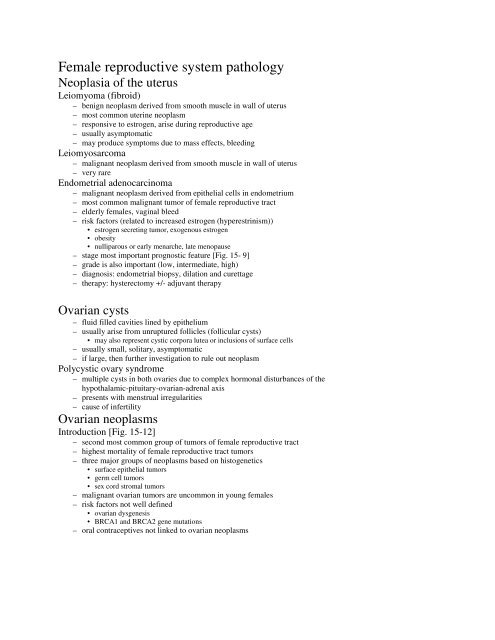Female reproductive system pathology
Female reproductive system pathology
Female reproductive system pathology
Create successful ePaper yourself
Turn your PDF publications into a flip-book with our unique Google optimized e-Paper software.
<strong>Female</strong> <strong>reproductive</strong> <strong>system</strong> <strong>pathology</strong>Neoplasia of the uterusLeiomyoma (fibroid)– benign neoplasm derived from smooth muscle in wall of uterus– most common uterine neoplasm– responsive to estrogen, arise during <strong>reproductive</strong> age– usually asymptomatic– may produce symptoms due to mass effects, bleedingLeiomyosarcoma– malignant neoplasm derived from smooth muscle in wall of uterus– very rareEndometrial adenocarcinoma– malignant neoplasm derived from epithelial cells in endometrium– most common malignant tumor of female <strong>reproductive</strong> tract– elderly females, vaginal bleed– risk factors (related to increased estrogen (hyperestrinism))• estrogen secreting tumor, exogenous estrogen• obesity• nulliparous or early menarche, late menopause– stage most important prognostic feature [Fig. 15- 9]– grade is also important (low, intermediate, high)– diagnosis: endometrial biopsy, dilation and curettage– therapy: hysterectomy +/- adjuvant therapyOvarian cysts– fluid filled cavities lined by epithelium– usually arise from unruptured follicles (follicular cysts)• may also represent cystic corpora lutea or inclusions of surface cells– usually small, solitary, asymptomatic– if large, then further investigation to rule out neoplasmPolycystic ovary syndrome– multiple cysts in both ovaries due to complex hormonal disturbances of thehypothalamic-pituitary-ovarian-adrenal axis– presents with menstrual irregularities– cause of infertilityOvarian neoplasmsIntroduction [Fig. 15-12]– second most common group of tumors of female <strong>reproductive</strong> tract– highest mortality of female <strong>reproductive</strong> tract tumors– three major groups of neoplasms based on histogenetics• surface epithelial tumors• germ cell tumors• sex cord stromal tumors– malignant ovarian tumors are uncommon in young females– risk factors not well defined• ovarian dysgenesis• BRCA1 and BRCA2 gene mutations– oral contraceptives not linked to ovarian neoplasms
















